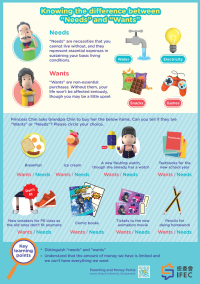Help children distinguish between “needs” and “wants” in 6 easy steps

If children think that money is for buying whatever they want, they may keep asking parents to buy them things when shopping, and have a never-ending wishlist.
Here are six steps to help your child understand that though we are born with the natural desire to want various things, we cannot have everything we want. Our wants are unlimited but we don’t have an infinite amount of money. Therefore, it is important to learn the difference between “needs” and “wants” and make the right choices.
Step 1: Explain the difference
“Needs” are necessities that you cannot live without. Without what we need, such as food and water, our lives or health may be compromised.
“Wants” are non-essential items. Without them, your life won’t be materially affected, though you may be upset for a while.
Step 2: Illustrate with examples
You may illustrate this with examples and ask your child to decide if an item is a “want” or “need”. Taking clothes as an example, if you already have a jacket but you want to buy another one with a new cartoon print, then it becomes a is “want”. If you do not have a warm jacket or a jacket that no longer fits to keep you warm, it is “need”.
Step 3: Strengthen the concept with activities
Download the “Knowing the difference between needs and wants” activity sheet to see if your child understands the concept.
In this activity sheet, Princess Chin asks Grandpa Chin to buy her different items. Ask your child to tell you if they are”wants” or “needs”.

“Knowing the difference between ‘needs’ and ‘wants’” activity sheet
Download here.
Step 4: Encourage good behaviours
While teaching the little ones this important concept, parents can also help to reinforce their understanding. Share with your child that we (including mom and dad) are born with the natural desire for beautiful or new things, and it is not wrong to have wants.
However, we need to carefully consider which wants can be satisfied since our finite amount of money can never meet our unlimited wants. Encourage your child to build good behaviours such as think twice before buying.
Step 5: Learn the concepts of “enough” and “content”
In today’s affluent society, parents may want to give their children the best things in life that they can afford. However, refrain from over-indulging or they will be caught up in chasing material possessions. Instead, teach them how to be content and cherish what they have and only buy what is needed.
Get your child involved in sharing what they have with others who are less fortunate. Reinforce the importance of thoughtful giving, rather than that of receiving.
Step 6: Be a role model
Last but not least, set a good example as a parent. If you are a big spender and tend to buy a lot of shoes, your child may think it is alright to do so too. Demonstrate to your child how you can put aside personal wants for the sake the family.
19 May 2020




